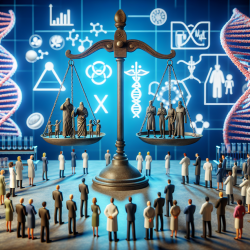Introduction
The SHANK3 gene has been identified as a significant contributor to neurodevelopmental disorders, including autism and Phelan-McDermid syndrome. Recent research, such as the study titled "SHANK3 Genotype Mediates Speech and Language Phenotypes in a Nonclinical Population," provides new insights into how variations in this gene affect speech and language traits in individuals without clinical diagnoses. This blog explores the findings of this study and discusses how practitioners can apply this knowledge to improve therapeutic outcomes.
Understanding SHANK3 and Its Role
SHANK3 is a synaptic scaffolding protein crucial for proper neuronal function. Mutations or deletions in this gene are known to cause Phelan-McDermid syndrome, characterized by developmental delays, intellectual disabilities, and speech impairments. The study by Manning et al. (2021) investigates the effects of the SHANK3 SNP rs9616915 on speech and language traits in a nonclinical population, revealing significant findings that could influence therapeutic practices.
Key Findings of the Study
The research identified that males with the TT genotype of the SHANK3 SNP rs9616915 exhibited higher scores on the Schizotypal Personality Questionnaire's Odd Speech subscale. This suggests that this genetic variation may influence speech and language development even in individuals without a clinical diagnosis of autism or Phelan-McDermid syndrome. These findings align with previous studies indicating that SHANK3 mutations affect vocalization and auditory processing in animal models.
Implications for Practitioners
Practitioners can leverage these findings in several ways:
- Genetic Screening: Consider incorporating genetic screening for SHANK3 variations in assessments, especially for males exhibiting speech and language difficulties.
- Tailored Interventions: Develop personalized intervention strategies that account for genetic predispositions, focusing on enhancing communication skills.
- Further Research: Encourage further research into SHANK3's role in speech and language development to refine therapeutic approaches and improve outcomes.
Encouraging Further Research
The study highlights the need for more extensive research into how genetic variations influence speech and language phenotypes. Practitioners are encouraged to collaborate with researchers to explore the neurological and psychological bases of these traits. Such collaboration could lead to breakthroughs in understanding and treating speech and language disorders associated with SHANK3 mutations.
Conclusion
The SHANK3 gene plays a critical role in speech and language development, even in nonclinical populations. By understanding the genetic underpinnings of these traits, practitioners can enhance their therapeutic strategies and contribute to the growing body of research in this field. To read the original research paper, please follow this link: SHANK3 Genotype Mediates Speech and Language Phenotypes in a Nonclinical Population.










